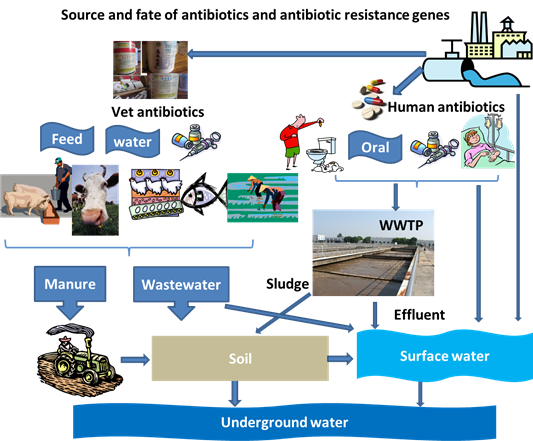Antibiotics are extensively used to prevent and/or treat diseases in human and animals, and also used as feed additive to promote growth of livestock animals. The wide application of antibiotics can lead to environmental contamination of antibiotic residues and development of bacterial resistance to antibiotics, which have become a global public concern. After administration of an antibiotic, a significant fraction is excreted in the parent form or its metabolite forms along with urine and feces, and then reaches the aquatic environment through direct discharge of wastes, or discharge of effluents from wastewater treatment plants due to incomplete removal. Moreover, antibiotics associated with land application of sludge and livestock manure can also enter into aquatic environment via surface runoff. Antibiotic residues can influence the bacterial diversity and microbial dynamics in the aquatic ecosystem. Besides inherent resistance, the occurrence of antibiotic resistance could be influenced by antibiotic residues, which exert the selective pressure on the microbial community in the environment.
With the support by the National Natural Science Foundation of China, National Water Pollution Control Program and Ministry of Environmental Protection of China, Professor Guang-Guo Ying’s research group reported for the first time the national consumption, emission and environmental contamination in whole China.
Based on this study, the total antibiotic usage in China for 2013 was estimated to be approximately 162000 tons. Human consumption accounted for about 48% of the total antibiotics, and the rest was shared by animals. In general, the average emission densities for the basins located in east and south China were more than 6 times higher than those in west China, with the basins being separated into two different regions by the famous geographic “Hu Huanyong line”, which reflects the huge impact of human activities on the distribution of antibiotics. The fugacity model successfully predicted environmental concentrations (PECs) in all 58 river basins of China, which are comparable to the reported measured environmental concentrations (MECs) available in some basins. The bacterial resistance rates in the hospitals and aquatic environments were found to be related to the PECs and antibiotic usages, especially for those antibiotics used in the most recent period. This is the first comprehensive study which demonstrates an alarming usage and emission of various antibiotics in China.

Figure 1. Contamination pathways for antibiotics in the environment.

Figure 2. Map of antibiotic contamination in Chinese river basins.
References:
(1) Zhang QQ, Ying GG, Pan CG, Liu YS, Zhao JL (2015) Comprehensive evaluation of antibiotics emission and fate in the river basins of China: Source analysis, multimedia modelling, and linkage to bacterial resistance. Environmental Science & Technology 49, 6772-6782.
(2) Su HC, Ying GG, Zhao JL, Zhou LJ, Liu YS, Tao R, Zang RQ, He LY (2014) Contamination profiles of antibiotic resistance genes in the sediments at a catchment scale. Science of the Total Environment 490, 708-714.
(3) Su HC, Ying GG, Tao R, Zhang RQ, Zhao JL, Liu YS (2012) Class 1 and 2 integrons, sul resistance genes and antibiotic resistance in Escherichia coli isolated from Dongjiang River, South China. Environmental Pollution 169, 42-49.
(4) Zhou LJ, Ying GG, Zhao JL, Yang JF, Wang L, Yang B, Liu S (2011) Trends in the occurrence of human and veterinary antibiotics in the sediments of the Yellow River, Hai River and Liao River in northern China. Environmental Pollution 159, 1877-1885.
(5) Tao R, Ying GG, Su HC, Zhou HW, Sidhu JPS (2010) Detection of antibiotic resistance and tetracycline resistance genes in Enterobacteriaceae isolates from the Pearl Rivers in South China. Environmental Pollution 158, 2101-2109.